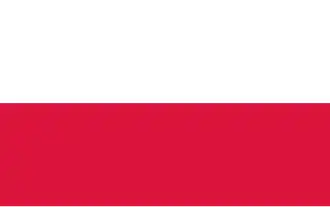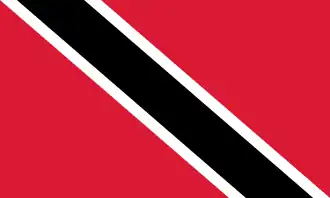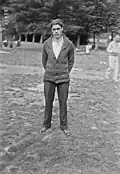Horatio May Fitch (December 16, 1900 Chicago, Illinois – May 4, 1985 Estes Park, Colorado) was an American athlete who competed mainly in the 400 metres.[1]
Fitch was an All-American runner for the Illinois Fighting Illini track and field team, placing 4th in the 400 m at the 1923 NCAA Track and Field Championships.[2]
He competed for the United States in the 1924 Summer Olympics held in Paris in the 400 metres where he won the silver medal, an event memorialized by the 1982 hit movie Chariots of Fire. The race winner was Eric Liddell, who had passed up the 100-metre dash, his specialty, because it was being held on Sunday.
After graduating with a degree in engineering, Fitch went to work for a company building Chicago's new Union Station. He found time, however, to compete for the Chicago Athletic Association. After winning the 1923 AAU 440-yard national championship with a time of 50.0 seconds, he was invited to participate in the Olympic tryouts at Harvard the month before the Paris Games. He finished behind Taylor, a Princeton graduate, who set a new world record of 48.1 in the semifinals and was one of nine quartermilers the U.S. took to Paris.
References
External links
|
|---|
1876-1979
Amateur Athletic Union | |
|---|
1980-1992
The Athletics Congress | |
|---|
1992 onwards
USA Track & Field | |
|---|
| Notes |
- Note 1: In 1888 both the NAAAA and the AAU held championships
- OT: The 1920, 1928, 1932, and since 1992, championships incorporated the Olympic Trials, otherwise held as a discrete event.
- 2020 OT: The 2020 Olympic Trials were delayed and held in 2021 due to the COVID-19 pandemic.
|
|---|
|
|---|
1906–1979
Amateur Athletic Union |
- 1906: Eli Parsons
- 1907: Eli Parsons
- 1908: Mel Sheppard
- 1909: Mel Sheppard
- 1910: Harry Gissing
- 1911: Abel Kiviat
- 1913: Abel Kiviat
- 1914: Thomas Halpin
- 1915: Thomas Halpin
- 1916: William Bingham
- 1917: Earl Eby
- 1918: Marvin Gustavson
- 1919: Jack Sellers
- 1920: Earl Eby
- 1921: Fred Murrey
- 1922: Sid Leslie
- 1923: Earl Eby
- 1924: Walter Mulvihill
- 1925: Vincent Lally
- 1926:
- 1927: George Leness
- 1928:
.svg.png) Phil Edwards (BGU), George Leness (2nd) Phil Edwards (BGU), George Leness (2nd)
- 1929:
.svg.png) Phil Edwards (BGU), Eddie Blake (2nd) Phil Edwards (BGU), Eddie Blake (2nd)
- 1930:
.svg.png) Phil Edwards (BGU), Eddie Roll (2nd) Phil Edwards (BGU), Eddie Roll (2nd)
- 1931:
.svg.png) Phil Edwards (BGU), Eddie Blake (4th) Phil Edwards (BGU), Eddie Blake (4th)
- 1932:
.svg.png) Alex Wilson (CAN), Edwin Roll (2nd) Alex Wilson (CAN), Edwin Roll (2nd)
- 1933: Milton Sandler
- 1934: Milton Sandler
- 1935: Milton Sandler
- 1936: Edward O'Brien
- 1937: Edward O'Brien
- 1938: Jim Herbert
- 1939: Charles Beetham
- 1940: Charles Belcher
- 1941: Jim Herbert
- 1942: Roy Cochran
- 1943: Lewis Smith
- 1944: Bob Ufer
- 1945: Elmore Harris
- 1946: Elmore Harris
- 1947: George Guida
- 1948: Dave Bolen
- 1949: Dave Bolen
- 1950: Hugo Maiocco
- 1951: Hugo Maiocco
- 1952: Charles Moore
- 1953: Mal Whitfield
- 1954: Reggie Pearman
- 1955: Charles Jenkins Sr.
- 1956: Lou Jones
- 1957: Charles Jenkins Sr.
- 1958: Charles Jenkins Sr.
- 1959: Josh Culbreath
- 1960: Tom Murphy
- 1961: Eddie Southern
- 1962:
.svg.png) Bill Crothers (CAN), Jack Yerman (2nd) Bill Crothers (CAN), Jack Yerman (2nd)
- 1963: Jack Yerman
- 1964: Charles Buchta
- 1965: Jack Yerman
- 1966: Theron Lewis
- 1967: Jim Kemp
- 1968: Martin McGrady
- 1969: Martin McGrady
- 1970: Martin McGrady
- 1971:
 Andrzej Badeński (POL), Tom Ulan (3rd) Andrzej Badeński (POL), Tom Ulan (3rd)
- 1972: Lee Evans
- 1973: Fred Newhouse
- 1974: Wes Williams
- 1975: Wes Williams
- 1976:
.svg.png) Fred Sowerby (ANT), Stan Vinson (2nd) Fred Sowerby (ANT), Stan Vinson (2nd)
- 1977:
.svg.png) Fred Sowerby (ANT), Kevin Prince (2nd) Fred Sowerby (ANT), Kevin Prince (2nd)
- 1978: Stan Vinson
- 1979:
 Mike Solomon (TRI), Stanley Vincent (3rd) Mike Solomon (TRI), Stanley Vincent (3rd)
|
|---|
1980–1992
The Athletics Congress | |
|---|
1993–present
USA Track & Field | |
|---|
| Notes | *Distances have varied as follows: 600 yards (1906–1986), 500 meters (1987–1993) except 600 meters (odd numbered years since 2015) |
|---|
|
|---|
| Track/road/cross country athletes | | |
|---|
| Field/combined event athletes | |
|---|
| Coaches and trainers | |
|---|

